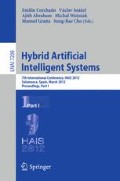Abstract
The assessment of failure force in bolted lap joints is a critical parameter in the design of steel structures. This kind of bolted joint shows a highly nonlinear behaviour so traditional analytical models are not very reliable. By contrast, other classical technique like finite element analysis provides a powerful tool to solve nonlinearities but usually with a high computational cost. In this article, we propose a data-driven approach based on multilayer-perceptron network ensemble model for failure force prediction, using a data set generated via finite element simulations of different bolted lap joints. Numeric ensemble methods combine multiple predictors to obtain a single output through average. Moreover, a procedure based on genetic algorithms is used to optimize the ensemble parameters. Results show greater generalization capacity than single prediction model. The resulting ensemble includes the advantages of finite element method whereas reduces the complexity and requires less computation.
Access this chapter
Tax calculation will be finalised at checkout
Purchases are for personal use only
Preview
Unable to display preview. Download preview PDF.
References
Annicchiarico, W., Cerrolaza, M.: Structural shape optimization 3d nite-element models based on genetic algorithms and geometric modeling. Finite Elements in Analysis and Design 37, 403–415 (2001)
Bishop, C.: Neural Networks for Pattern Recognition. Oxford University Press, Oxford (1995)
Breiman, L.: Bagging predictors. Machine Learning 24, 123–140 (1996)
Bursi, O.S., Jaspart, J.P.: Benchmarks for finite element modelling of bolted steel connections. Journal of Constructional Steel Research 43(1-3), 17–42 (1997)
Corchado, E., Abraham, A., Carvalho, A.: Hybrid intelligent algorithms and applications. Information Sciences 180(14), 2633–2634 (2010)
Corchado, E., Graña, M., Wozniak, M.: New trends and applications on hybrid artificial intelligence systems. Neurocomputing 75(1), 61–63 (2012)
European Committee for Standardization: EN 10025-2: 2004. Non-alloy structural steels: grades, mechanical properties and nearest equivalent grades
European Committee for Standardization: EN 1993-1-8 Eurocode 3. Design of steel structures part 1-8. Design of joints
Fernández, J., Pernía, A., de Pisón, F.M., Lostado, R.: Prediction models for calculating bolted connections using data mining techniques and the finite element method. Engineering Structures 32(10), 3018–3027 (2010)
Friedman, J.H., Popescu, B.E.: Importance sampled learning ensembles. Tech. rep., Stanford University, Department of Statistics (2003)
Garcia-Pedrajas, N., Hervas-Martinez, C., Ortiz-Boyer, D.: Cooperative coevolution of artificial neural network ensembles for pattern classification 9(3), 271–302 (2005)
Hansen, L.K., Salamon, P.: Neural network ensembles 12(10), 993–1001 (1990)
Hornik, K., Stinchcombe, M.B., White, H.: Multilayer feedforward networks are universal approximators. Neural Networks 2(5), 359–366 (1989)
Jones, M.T.: Artificial Intelligence: A Systems Approach. Infinity Science Press, LLC (2008)
Ju, S.-H., Fan, C.-Y., Wu, G.H.: Three-dimensional finite elements of steel bolted connections. Engineering Structures 26(3), 403–413 (2004)
Kim, T.S., Kuwamura, H., Cho, T.J.: A parametric study on ultimate strength of single shear bolted connections with curling. Thin-Walled Structures 46(1), 38–53 (2008)
Loureiro, A., Gutiérrez, R., Reinosa, J., Moreno, A.: Axial stiffness prediction of non-preloaded t-stubs: An analytical frame approach. Journal of Constructional Steel Research 66(12), 1516–1522 (2010)
Ovaska, S.J., Kamiya, A., Chen, Y.: Fusion of soft computing and hard computing: computational structures and characteristic features 36(3), 439–448 (2006)
Salih, E.L., Gardner, L., Nethercot, D.A.: Numerical investigation of net section failure in stainless steel bolted connections. Journal of Constructional Steel Research 66(12), 1455–1466 (2010)
Yang, Y.-Y., Mahfouf, M., Pnoutsos, G.: Development of a parsimonious ga-nn ensemble model with a case study for charpy impact energy prediction. Advances in Engineering Software 42, 435–443 (2011)
Author information
Authors and Affiliations
Editor information
Editors and Affiliations
Rights and permissions
Copyright information
© 2012 Springer-Verlag Berlin Heidelberg
About this paper
Cite this paper
Fernández-Ceniceros, J., Sanz-García, A., Antoñanzas-Torres, F., Martínez-de-Pisón-Ascacibar, F.J. (2012). Multilayer-Perceptron Network Ensemble Modeling with Genetic Algorithms for the Capacity of Bolted Lap Joint. In: Corchado, E., Snášel, V., Abraham, A., Woźniak, M., Graña, M., Cho, SB. (eds) Hybrid Artificial Intelligent Systems. HAIS 2012. Lecture Notes in Computer Science(), vol 7208. Springer, Berlin, Heidelberg. https://doi.org/10.1007/978-3-642-28942-2_49
Download citation
DOI: https://doi.org/10.1007/978-3-642-28942-2_49
Publisher Name: Springer, Berlin, Heidelberg
Print ISBN: 978-3-642-28941-5
Online ISBN: 978-3-642-28942-2
eBook Packages: Computer ScienceComputer Science (R0)

